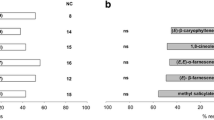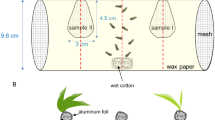Abstract
An oviposition bioassay for the onion maggot,Hylemya antiqua (Meigen), is described in which females, in response to volatile stimulants, oviposit through small apertures onto moistened filter paper. Onion volatiles that act as attractants and oviposition stimulants were captured in Porapak Q from air passed over chopped onions in glass chambers. Pentane extracts from odor-impregnated Porapak Q induced ∼ 30–50% of the oviposition that occurred in response to 15-g onion-slice stimuli. Extracts presented in pentane on waxed dental cotton wicks induced more constant oviposition over a 3-day period than extracts on unwaxed wicks. Extract of the Porapak Q-captured volatiles from bulbs of fresh, actively growing onions elicited a much stronger response than did stem and leaf extracts from the same onions. The bioassay techniques and chemical procedures developed in this study could be used in chemical isolation programs for host attractants or oviposition stimulants forH. antiqua or similar species.
Similar content being viewed by others
References
Allen, W.R., andAskew, W.L. 1973. A simple technique for mass rearing the onion maggot on an artificial diet.Can. Entomol. 102:1554–1558.
Berüter, J., andStädler, E. 1971. An ovipositional stimulant for the carrot rust fly from carrot leaves.Z. Naturforsch. 26b:339–340.
Byrne, K.J., Gore, W.E., Pearce, G.T., andSilverstein, R.M. 1975. Porapak Q collection of airborne organic compounds serving as models for insect pheromones.J. Chem. Ecol. 1:1–7.
Carson, J.F., andWong, F.F. 1961. The volatile flavor components of onion.J. Agric. Food Chem. 9:140–143.
Hedin, P.A., Maxwell, F.G., andJenkins, J.N. 1974. Insect plant attractants, feeding stimulants, repellents, deterrents, and other related factors affecting insect behavior. Pages 494–527,in F.G. Maxwell and F.A. Harris (eds.),Proceedings of the summer institute on biological control of plant insects and diseases. University of Mississippi Press, Jackson, Mississippi. 647 pp.
Matsumoto, Y., andThorsteinson, A.J. 1968. Effect of organic sulphur compounds on oviposition in onion maggots,Hylemya antiqua Meigen (Diptera:Anthomyiidae).Appl. Entomol. Zool. 3:5–12.
Niegisch, W.D., andStahl, W.H. 1956. The onion: Gaseous emanation products.Food Res. 21:657–665.
Peacock, J.W., Cuthbert, R.A., Gore, W.E., Lanier, G.N., Pearce, G.T., andSilverstein, R.M. 1975. Collection on Porapak Q of the aggregation pheromone ofScolytus multistriatus (Coleoptera:Scolytidae).J. Chem. Ecol. 1:149–160.
Stutz, R.E., andShriner, R.L. 1933. The preparation and properties of methylene di-n-butyl disulfone.J. Am. Chem. Soc. 55:1212–1244.
Tiechler, J. 1971. Rearing of the onion fly,Hylemya antiqua (Meigen), with a view to release of sterilized insects. Pages 341–346,in sterility principle for insect control or eradication. International Atomic Energy Agency, Vienna.
Traynier, R.M.M. 1967. Stimulation of oviposition by the cabbage root fly,Erioshia brassicae. Entomol. Exp. Appl. 10:321–328.
Author information
Authors and Affiliations
Additional information
Diptera:Anthomyiidae.
Research supported by National Research Council of Canada, Grant Nos. A3881 and A3706.
Rights and permissions
About this article
Cite this article
Vernon, R.S., Borden, J.H., Pierce, H.D. et al. Host selection byHylemya antiqua laboratory bioassay and methods of obtaining host volatiles. J Chem Ecol 3, 359–368 (1977). https://doi.org/10.1007/BF00988179
Received:
Revised:
Issue Date:
DOI: https://doi.org/10.1007/BF00988179




